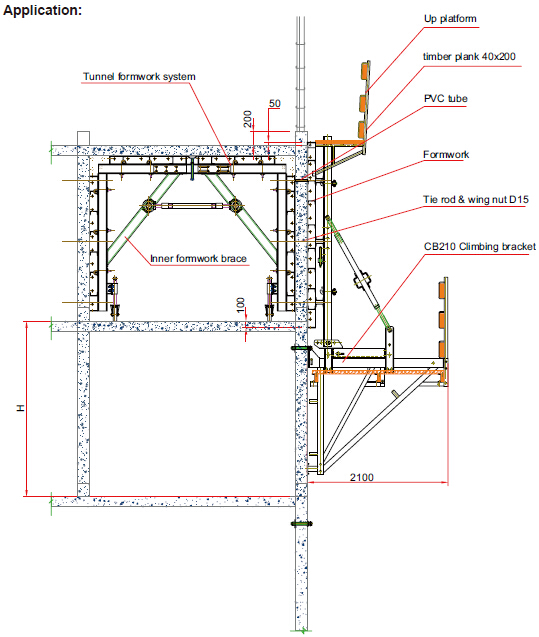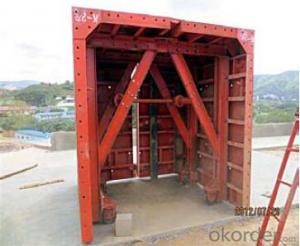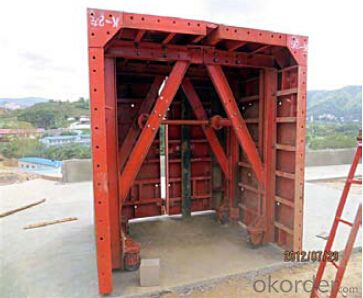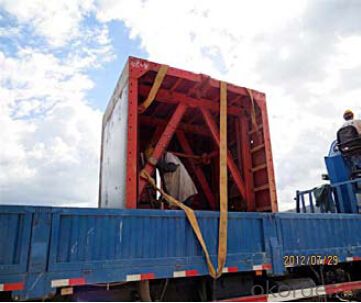Steel Tunnel for Formwork and Scaffolding system
- Loading Port:
- Tianjin
- Payment Terms:
- TT OR LC
- Min Order Qty:
- 50 m²
- Supply Capability:
- 1000 m²/month
OKorder Service Pledge
Quality Product, Order Online Tracking, Timely Delivery
OKorder Financial Service
Credit Rating, Credit Services, Credit Purchasing
You Might Also Like
Building Tunnel Formwork:
A compositional steel formwork system mainly used in the building which has regular structure
without beams, the excellent formwork system can make the integral pouring for the wall & slab
easily achieved.
Characteristics:
◆ High stiffness, make perfect shape for concrete.
◆ Easy operation, save labor and force.
◆ Fast forming, repeatedly turnover.

- Q: Can steel formwork be used for architectural concrete walls with complex geometries?
- Yes, steel formwork can be used for architectural concrete walls with complex geometries. Steel formwork offers excellent strength and durability, making it suitable for creating intricate shapes and designs in concrete walls. It provides the necessary support and stability during the casting process, ensuring that the concrete retains its desired form and shape. Additionally, steel formwork is versatile and can be easily customized to meet the specific requirements of complex architectural designs.
- Q: What are the advantages and disadvantages of the application of the steel formwork and the plywood formwork in the construction?
- From the aspect of Construction: the construction speed of the large steel formwork is fast, the quality effect is good; the wood formwork is assembled slowly, and the bulging phenomenon is easy to occur;
- Q: What are the different types of safety systems used with steel formwork?
- There are several different types of safety systems that are commonly used with steel formwork to ensure the safety of workers and prevent accidents on construction sites. Some of the most common safety systems used with steel formwork include: 1. Guardrails: Guardrails are typically installed along the edges of the formwork to prevent workers from falling off or slipping. They are usually made of steel or aluminum and are designed to withstand a certain amount of force. 2. Safety harnesses: Safety harnesses are worn by workers and are attached to a secure anchor point to prevent falls. They are typically made of strong, durable materials and are adjustable to fit different body sizes. 3. Toe boards: Toe boards are installed at the bottom of the formwork to prevent tools, materials, or debris from falling off the structure. They are typically made of plywood or steel and are securely attached to the formwork. 4. Safety nets: Safety nets are installed beneath the formwork to catch falling objects or workers in case of an accident. They are made of strong, flexible materials and are capable of absorbing the impact of a fall. 5. Ladders and stairs: Ladders and stairs are used to provide safe access to and from the formwork. They are typically made of steel or aluminum and are designed to be sturdy and stable. 6. Warning signs and barricades: Warning signs and barricades are used to alert workers and visitors to potential hazards and restricted areas. They are typically made of durable materials and are brightly colored for high visibility. 7. Personal protective equipment (PPE): Personal protective equipment, such as hard hats, safety glasses, and steel-toed boots, is an essential safety system used with steel formwork. PPE is designed to protect workers from head injuries, eye injuries, and foot injuries. It is important to note that the specific safety systems used with steel formwork may vary depending on the specific project requirements and regulations. It is crucial for construction companies and workers to follow all safety guidelines and regulations to ensure a safe working environment.
- Q: What are the different surface treatments available for steel formwork panels?
- Some of the different surface treatments available for steel formwork panels include galvanizing, powder coating, and epoxy coating. These treatments help to protect the panels from corrosion, enhance their durability, and improve their overall appearance.
- Q: Are there any specific quality control measures for steel formwork installation?
- Yes, steel formwork installation has specific quality control measures in place to guarantee correct installation and adherence to required standards. Before installation, one key quality control measure involves inspecting the steel formwork for damages, defects, or deviations from specifications. Any issues discovered during the inspection must be addressed and resolved before proceeding with installation. Verifying the dimensions and alignment of the steel formwork is another quality control measure. This ensures that the formwork is fabricated accurately and aligned properly with the structure. Inaccurate dimensions or misalignment can cause issues during concrete pouring and impact the final structure's quality. Furthermore, quality control measures include checking the stability and strength of the steel formwork. This involves confirming that the formwork is adequately braced and supported to withstand the concrete's pressure. It's crucial to ensure that the formwork can bear the load without deforming or failing. Moreover, closely monitoring the installation process itself is essential to ensure compliance with required procedures and standards. This includes verifying that the formwork is securely fastened and all connections are properly made. Any deviations from installation procedures should be promptly addressed and corrected. Regular inspections and audits should be conducted throughout the installation process to track progress and identify potential issues. This allows for timely interventions and corrections, ensuring that the steel formwork installation meets required quality standards. In conclusion, specific quality control measures are crucial for steel formwork installation to ensure the structure's integrity and safety. By implementing these measures, potential issues or defects can be identified and resolved early on, minimizing the risk of expensive rework or structural failures.
- Q: Can steel formwork be used for both above-ground and below-ground structures?
- Yes, steel formwork can be used for both above-ground and below-ground structures. Steel formwork is known for its strength, durability, and versatility, making it suitable for various construction projects. Above-ground structures, such as buildings and bridges, often require formwork to shape and support the concrete during the casting process. Steel formwork provides the necessary strength and stability to withstand the weight and pressure of the concrete. Similarly, below-ground structures like basements, tunnels, and foundations can also benefit from steel formwork. These structures often require formwork to create the desired shape and provide support during the concrete pouring and curing phases. Steel formwork can withstand the pressure exerted by the surrounding soil and groundwater, ensuring the integrity of the structure. Moreover, steel formwork offers advantages such as reusability, easy assembly and disassembly, and the ability to withstand harsh environmental conditions. These characteristics make it an ideal choice for both above-ground and below-ground construction projects, where durability and efficiency are crucial. However, it is important to consider the specific requirements of each project and consult with structural engineers and construction experts to ensure the appropriate formwork system is selected.
- Q: What are the different safety features incorporated in steel formwork systems?
- Workers' protection and the overall success of construction projects are ensured by steel formwork systems, which are equipped with numerous safety features. These features include: 1. Robust Construction: Steel formwork systems are constructed using high-quality steel materials, providing strength and stability. This strong construction reduces the risk of collapse or structural failure, ensuring the safety of workers. 2. Adjustable Support Systems: Props and jacks are incorporated into steel formwork systems to allow for precise adjustment and leveling. This ensures stability and prevents the formwork from shifting or collapsing. 3. Guardrails and Toe Boards: Standard safety features of steel formwork systems include guardrails and toe boards. These prevent workers from falling off the edges of the formwork, reducing the risk of accidents and injuries at height. 4. Non-Slip Surfaces: To enhance safety, steel formwork systems often have non-slip surfaces. These surfaces provide better traction and reduce the likelihood of workers slipping or falling, especially in wet or slippery conditions. 5. Safety Accessories: Many steel formwork systems come with additional safety accessories, such as safety nets, harnesses, and personal protective equipment (PPE). These accessories provide further protection for workers, preventing falls and ensuring compliance with safety regulations. 6. Easy Assembly and Dismantling: Steel formwork systems are designed for easy assembly and dismantling, minimizing the time workers spend at height. This reduces the risk of accidents during construction and promotes efficient workflow. 7. Fire Resistance: Steel formwork systems are often fire-resistant or fire-retardant, increasing safety in case of fire emergencies. This feature helps to prevent the rapid spread of fire and provides additional time for evacuation or firefighting. 8. High Load-Bearing Capacity: Steel formwork systems are engineered to have a high load-bearing capacity, allowing them to support heavy concrete loads. This ensures that the formwork can withstand the weight without deformation or failure, enhancing safety during construction. In conclusion, steel formwork systems prioritize worker safety and contribute to a safer working environment through their sturdy construction, adjustable support systems, guardrails, non-slip surfaces, safety accessories, easy assembly and dismantling, fire resistance, and high load-bearing capacity.
- Q: How does steel formwork contribute to the overall safety of the construction process?
- There are several ways in which steel formwork enhances the safety of the construction process. Firstly, its strength and durability allow it to withstand the weight and pressure exerted during construction, reducing the possibility of formwork failure and subsequent accidents or injuries. Moreover, steel formwork is specifically designed to create a stable and secure structure for pouring concrete. Its precise alignment and tight joints prevent any leakage or seepage of concrete, thus minimizing the chances of structural instability or collapse. This ensures the safety of workers and the overall integrity of the building under construction. Furthermore, steel formwork exhibits high resistance to fire and high temperatures. In the unfortunate event of a fire on the construction site, it acts as a fire-resistant barrier, protecting workers and preventing the spread of fire to other areas. Consequently, the risk of fire-related accidents or injuries is greatly reduced, enhancing the overall safety of the construction process. In addition, steel formwork is designed to be reusable, allowing it to be utilized for multiple construction projects. This not only reduces formwork costs but also minimizes waste and environmental impact. By opting for steel formwork, construction companies can promote sustainability and create a safer construction environment by minimizing the need for constant formwork replacement. In conclusion, steel formwork makes a significant contribution to the overall safety of the construction process by providing strength, durability, stability, and fire resistance. Its precise alignment and tight joints ensure the integrity of the structure being built, diminishing the risk of accidents or collapse. Additionally, its reusability supports sustainability efforts and waste reduction. Overall, steel formwork plays a vital role in establishing a safe and secure construction site.
- Q: How does steel formwork affect the overall durability of the structure?
- Steel formwork can have a significant impact on the overall durability of a structure. Steel is known for its strength and durability, making it an ideal material for formwork. One of the key ways in which steel formwork affects the durability of a structure is through its ability to withstand the forces and pressures exerted during the construction process. Steel formwork provides excellent support and stability to the concrete during pouring and curing, ensuring that it maintains its shape and strength. This helps to prevent any deformation or cracking that could compromise the overall durability of the structure. Additionally, steel formwork is highly resistant to wear and tear, which is crucial for projects that involve multiple concrete pours. Unlike other types of formwork such as timber, steel formwork does not warp, shrink, or expand due to moisture or temperature changes. This allows for multiple uses and reuses, reducing the need for frequent replacements and ultimately increasing the lifespan of the structure. Furthermore, steel formwork offers superior protection against environmental factors such as corrosion and fire. Steel is inherently resistant to rust and decay, which can significantly extend the lifespan of the formwork and consequently the structure itself. Moreover, steel formwork provides higher fire resistance compared to other materials, reducing the risk of structural damage and enhancing the overall durability of the building. In summary, steel formwork positively affects the overall durability of a structure by providing excellent support, stability, and protection against various forces and environmental factors. Its strength, resistance to wear and tear, and superior properties make it a reliable choice for construction projects, ensuring the longevity and durability of the structure.
- Q: Can steel formwork be used in bridge construction?
- Bridge construction can indeed utilize steel formwork. This entails the utilization of steel panels or frames to achieve the desired shape and structure of the bridge during the construction phase. The preference for steel formwork in bridge construction is largely due to its exceptional durability, strength, and capacity to endure the significant loads and stresses that bridges are subjected to. Moreover, it has the ability to withstand the heavy pouring of concrete and can be used repeatedly, rendering it a cost-effective option for bridge construction. Furthermore, steel formwork permits design flexibility, enabling the construction of intricate and complex shapes, thereby ensuring that the bridge meets the desired specifications and requirements. In conclusion, steel formwork is highly favored in bridge construction owing to its strength, durability, reusability, and versatility.
Send your message to us
Steel Tunnel for Formwork and Scaffolding system
- Loading Port:
- Tianjin
- Payment Terms:
- TT OR LC
- Min Order Qty:
- 50 m²
- Supply Capability:
- 1000 m²/month
OKorder Service Pledge
Quality Product, Order Online Tracking, Timely Delivery
OKorder Financial Service
Credit Rating, Credit Services, Credit Purchasing
Similar products
Hot products
Hot Searches
Related keywords



















